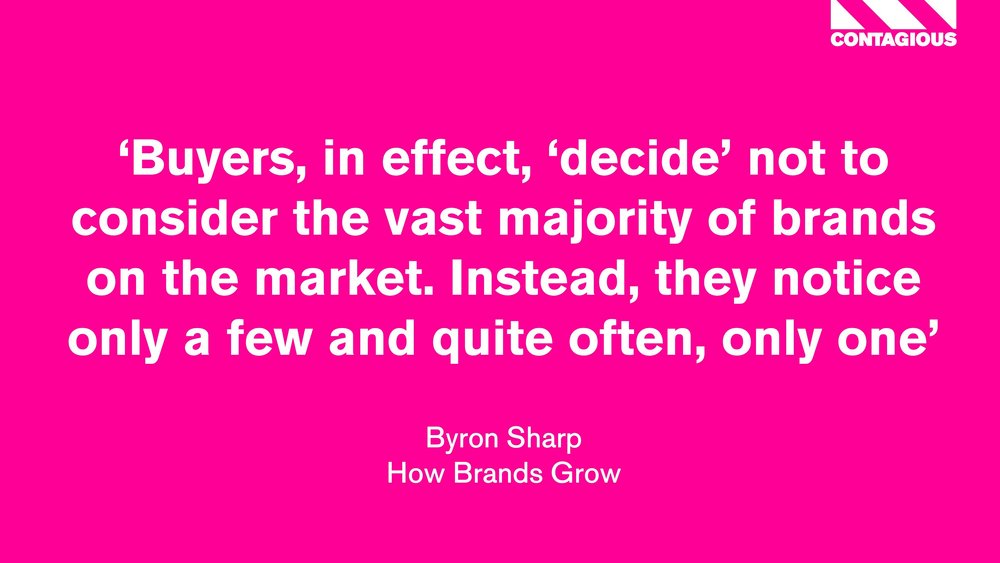AT A GLANCE /
- How Brands Grow 1 & How Brands Grow 2 are the 2010 and 2015 books by Ehrenberg-Bass Institute professors Byron Sharp and Jenni Romaniuk.
- These two books prove that brands should not focus on increasing the loyalty of a very specific audience. Instead, they should appeal to the whole market.
- Brands should also not aim to establish intimate emotional connections with people. Rather, they should make the process of buying less cognitively onerous by increasing mental and physical availability.
- Brands should not try to substantively differentiate themselves and carve out a unique place in the market, but should focus on ‘meaningless distinctiveness’.
OVERVIEW /
Early in How Brands Grow, its author Professor Byron Sharp quotes Mark Twain’s observation that ‘Education consists mainly of what we have unlearned.’
This objective of helping people ‘unlearn’ the unhelpful myths that are pervasive in marketing runs through both How Brands Grow and How Brands Grow 2. The first book sets out a number of headline arguments and laws; the second book develops these ideas with additional data from a wide range of markets.
Sharp and co-author Jenni Romaniuk set out to fight a number of marketing myths:
- the idea that brands should aim to establish deep, emotional relationships with consumers
- that differentiation and consumer segmentation are critical for brand growth
- that marketing efforts should be focused on achieving the exclusive loyalty of a brand’s heaviest buyers.
Sharp and Romaniuk argue that these myths are the modern equivalent of medieval blood-letting – they give practitioners a sense of control, but are ineffective and often actively harmful.
What the authors offer in place of this type of ‘esoteric quackery’ is a manifesto of evidence-based marketing, with law-like patterns and rules rooted in scientific analysis of what actually works in practice, rather than what might sound correct in theory.
There are two central themes that run through the books: who you target, and how you communicate.
WHO YOU TARGET /
In How Brands Grow, Sharp identifies how marketing consultant Philip Kotler and others have declared that mass marketing is old-fashioned. Modern marketing is supposedly about ‘focusing on loyal, heavier buyers; focusing on retention (not acquisition) and return on investment’. This approach to marketing has seen vast swathes of marketing budgets being sunk into CRM systems and loyalty schemes in the hope of getting existing customers to spend more and become 100% loyal to the brand.
This, however, is flawed. Loyalty is not an objective in and of itself. It is, instead, a function of penetration. The ‘Double Jeopardy Law’, an empirical marketing law discovered by Andrew Ehrenberg, shows that brand loyalty is positively correlated with brand penetration – if you have higher levels of penetration then your customers will, on average, be more loyal; if you have lower levels of penetration then your customers will, on average, be less loyal. Therefore, ‘smaller brands get “hit twice”: their sales are lower because they have fewer buyers, who buy the brand less often’.

The goal for brands should therefore be to recruit as many customers as possible. Every brand has a number of heavy buyers, and then a ‘long tail’ of occasional buyers. Attracting these light buyers is where the battle for market share is won or lost.
As a result, brands need to target the whole market, appealing to a broad range of people, rather than focusing on a highly loyal, highly segmented consumer niche. There is no particular type of consumer for Brand A, and a different type of consumer for Brand B. In the words of marketing researcher Andrew Ehrenberg, ‘Your customers are really other people’s customers who occasionally buy you.’
HOW YOU COMMUNICATE /
Sharp quotes former Saatchi & Saatchi CEO Kevin Roberts’ Lovemarks website: ‘Lovemarks are brands that create an intimate emotional connection that you simply can’t do without. Ever.’ The portrait is of consumers who are desperately interested in brands and desperate to develop emotional, anthropomorphic relationships with them.
This, say Sharp and Romaniuk, is nonsense. Consumers are largely apathetic to brands, and brand choice is ‘trivial’. What’s more, ‘advertising and packaging has a very weak psychological effect’. Effective marketing doesn’t build relationships with consumers, or stress clear points of differentiation to people who are willing to listen. Instead, it makes the tiresome issue of brand choice less cognitively onerous for people.
This is done by building mental and physical availability.
Physical availability is about making your brand easy to buy through wide distribution networks, prominent in-store positioning etc.
Mental availability is about making your brand easy to buy by making it come to mind easily and often in buying situations, and this is done through memory.

Brands must build and refresh memory structures. Emotion, rather than rational persuasion, is key to building memories. But memories should also be built to incorporate ‘distinctive brand assets’ – colours, logos, typefaces – that are both recognisable and linked to the brand. In Romaniuk’s terminology, they should be high on fame and high on uniqueness.
When consumers see these distinctive brand assets, they will act as a cue for branded memories. The advice is that brands should aim for meaningless distinctiveness, rather than meaningful differentiation [i.e. focus on being instantly recognisable more than communicating how a product is different to a competitor’s]
Similarly, brands should build cognitive associations with category entry points – the buyer’s thoughts or influences at the start of buying from the category (eg. ‘something refreshing’ would be a category entry point for soft drinks). Bigger, more successful brands are associated with more category entry points.
This approach shuns the idea of consumer intimacy with brands, and instead promotes the more plausible idea of successful brands making life cognitively easier for fundamentally apathetic and distracted consumers.
KEY QUOTES /
- ‘Buyers, in effect, “decide” not to consider the vast majority of brands on the market. Instead they notice only a few and quite often, only one.’
- ‘No marketing activity, including innovation, should be seen as a goal in itself, its goal is to hold on to or improve mental and physical availability.’
- ‘Advertising works largely by refreshing, and occasionally building, memory structures (and less by convincing rational minds or winning emotional hearts).’
- ‘When you look at brands of markedly different sizes you typically see that their penetration metrics differ a lot, while their average purchase rate varies little. Put another way: loyalty doesn't vary much.’
- ‘Marketing has the best chance of being successful when it has as much reach as possible. Marketing is particularly successful when it reaches light and non-buyers of a brand.’
This summary is part of Contagious Key Books, a resource dedicated to decoding critical marketing texts for busy, hard-working people like you. For other titles in this series, please visit the Contagious Key Books library.
Any book featured here is a recommendation that you should read it in full.







